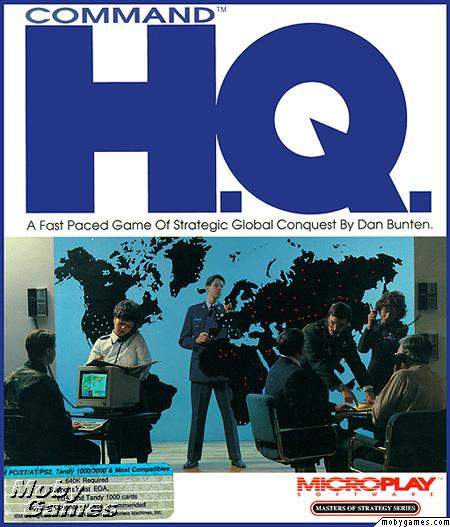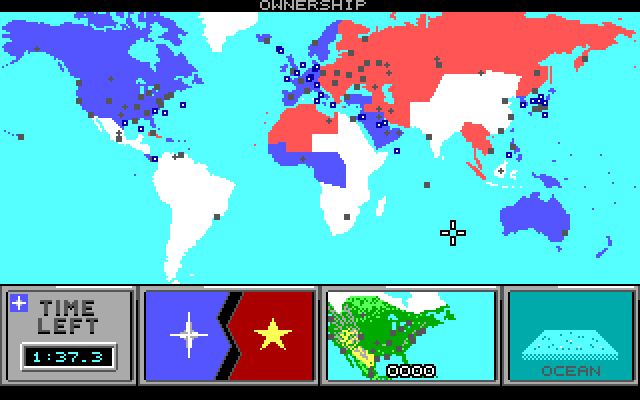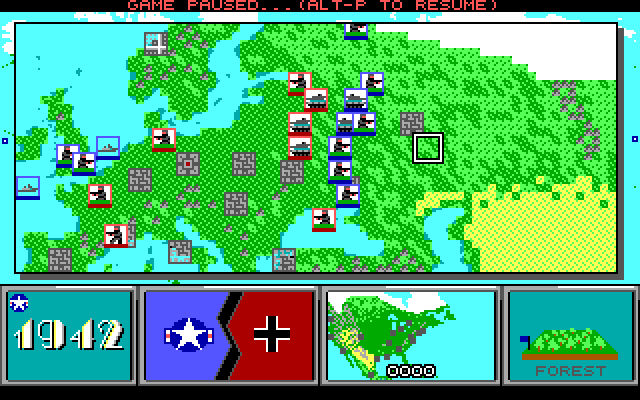An appreciation: “Command H.Q.”
 We live in a golden age of retro-gaming. With the emergence of services like GOG and the addition of titles from the ’80s and ’90s to Steam, as well as the tireless efforts of the Internet Archive, many classic games from the past that had seemed lost forever due to the rapid evolution of the home PC as a platform are available once more to be experienced and enjoyed.
We live in a golden age of retro-gaming. With the emergence of services like GOG and the addition of titles from the ’80s and ’90s to Steam, as well as the tireless efforts of the Internet Archive, many classic games from the past that had seemed lost forever due to the rapid evolution of the home PC as a platform are available once more to be experienced and enjoyed.
While there’s been an enormous amount of progress in this field over the last five years, however, there are still some classic games that are unavailable to play in any legal fashion. There’s many reasons why this might be the case; the ownership of the title might be ambiguous due to it passing through many corporate mergers, or it may contain material like music or video footage that requires separate licensing agreements too onerous or expensive for archivists to obtain. Whatever the reason, though, it’s a loss for our collective memory.
To push back against that loss, I’d like to take a moment to tell you about one of my favorite games of all time, a game that is sadly still stuck in “abandonware” limbo: 1990’s Command H.Q.
Designed by legendary game designer Dani Bunten Berry, whose portfolio also included the warmly remembered M.U.L.E. and The Seven Cities of Gold, Command H.Q. was an ambitious effort. It aimed let the player fight either side of four major wars: World War I, World War II, World War III (a hypothetical war between NATO and the then-still-in-existence Warsaw Pact), and “World War IV” (a hypothetical war between two randomly generated world empires).
This was a big goal, because World War I was a very different conflict than World War III would have been. But Berry & company met their goal by crafting a game design that was both simple and subtle; Command H.Q. is a classic example of the game that is “easy to learn, but hard to master.”
Part of the genius of their design was the way they approached the differences between the wars the game simulated. They formed, in effect, a sort of rolling tutorial. In the first scenario, World War I, there are only three types of units for the player to use: infantry divisions, naval cruisers, and submarines. Each subsequent scenario adds a few more unit types, however, so by World War III you’re pushing around armored divisions, aircraft carriers, satellites (and satellite-killer missiles), and nukes. But if you started out with the relative simplicity of the WWI scenario and played from there, it never gets overwhelming; each new bit of complexity is provided in an easy-to-swallow, bite-size chunk.
Command H.Q. also shone in the quality of its graphic presentation. Despite being limited to EGA graphics, which provided a palette of only 16 colors, it provides a rich, vibrant world map and clearly delineated, easy-to-understand unit icons.

Command H.Q.: world map (1942 scenario)
Each black dot on the map is a city or military base, meaning it’s a strategic point for the two sides to fight over. Blue icons are Allied/UN/NATO units; red are Central Powers/Axis/Warsaw Pact. You can see how, at a glance, it’s easy to see the disposition of forces for both sides around the world. (Though the player can only see enemy units that are within sight of one of their units or cities; so, since this picture was taken with me playing Blue, there could be other Red units lurking in the heart of Germany or the vast reaches of the Pacific.)
By default, the map displayed is a topographical map, showing the various types of terrain and climate in different places — green for temperate, dark green for jungle, yellow for desert, gray for mountains, white for Arctic. This is important information, because in Command H.Q. units that move across hostile territory take “attrition” (losses) as they do so; this means that, if you send a division marching across the Sahara or the Rockies, it will come out on the other side weakened and vulnerable. (Indeed, if its trek is too long, it may not come out at all.) This creates natural strategic obstacles that the player has to contend with; Russia, for instance, is protected from invasion by Japan in the east by the formidable deserts, mountains, and tundra of Siberia. Which is not to say such an invasion is impossible; it’s just very difficult, as it would have been in real life.
However, if you want to see the political division of the world rather than its topographical features, Command H.Q. provided a switch that let you do that too.

Command H.Q.: political map (1986 scenario)
And — this is the bit that was really mind-blowing, in 1990 — if you right-clicked anywhere on the map, it would zoom in to show you the particular area you’d clicked on in more detail:

Command H.Q.: the Eastern Front, zoomed in (1942 scenario)
Now you can see what I meant about the unit icons being colorful and easy to understand — you can tell right away what’s going on here; a tank-heavy Red (German, in this scenario) army is going up against an infantry-heavy Blue (Russian) army.
All of these illustrations may make the game appear pretty simple; but clear and simple are different things, and in many ways Command H.Q. was actually quite forward-thinking for its time. These included:
- Moving units around was just a matter of clicking on a unit, then clicking on where you wanted it to go. The game would figure out how to get it there for you. This highlights another thing about Command H.Q. that was revolutionary in 1990: it was designed from the ground up around the idea that the player was using a mouse. That hardly seems revolutionary today, of course, but in 1990, in the world of PC gaming, it was a huge assumption; 1990 was in the heyday of MS-DOS, before Microsoft Windows became anything more than a toy, and as a result it was the rare PC owner who had a mouse hooked up to their computer. Command H.Q. offered ways to work around not having a mouse, if you needed them (the big one was that it would let you use a joystick), but the game was clearly designed around the mouse in ways that few games of its era were. In this respect, it may have been too far ahead of its time.
- Unlike nearly all strategy games of its era, Command H.Q. was played in “real time.” In other words, there was no concept of “turns” or “phases”; when you started a game a clock started running, and either player could make as many moves in each second or minute as they wished. This would become the signature of the “real time strategy” genre that would explode in popularity over the next decade, but Command H.Q. was doing it in 1990, on PCs with lowly 4.77 MHz processors.
- Long before the Internet became a thing ordinary people had access to, Command H.Q. offered online multiplayer out of the box. All you and a friend needed to go to war with each other was two modems or a null modem adapter.
And beyond all that, there were a host of little touches that showed the designers’ spirit and sense of humor. No matter which side you were on, for instance, when you started a new war, a banner would be displayed at the bottom of the screen reading “ENEMY PROVOCATION FORCED US TO FIGHT!” Which is a pretty accurate rendition of the lies nation-states tell themselves when they go to war in the modern era; even Hitler’s Germans believed that they had been pushed into war by Britain and Poland.
The first PC war game to be widely acclaimed as a game for ordinary people — a “beer and pretzels” game, as the industry terminology goes — was SSI’s 1994 hit, Panzer General. But in my opinion, Command H.Q. got there first. It was a game you could pick up and play without needing a master’s degree in military history, but it was also smart enough to teach you lessons about why the wars of the 20th century played out the way they did. And most importantly, if you at all like strategy games, it was fun. Fun enough that, here in 2014, nearly a quarter-century after it was released, I’m still playing it.
So it makes me sad to see it lost in the murky fog of abandonware. People should be able to pay $5 or $10 or whatever and play it today. It didn’t find the audience it probably should have when it was released, but it’s an important part of gaming history — not least, as a monument to the genius of Dani Bunten Berry, one of the true giants of the early gaming industry — and it deserves to be out there to be found and appreciated.
UPDATE (June 12, 2015): To my surprise, I discovered today that you can buy Command H.Q. on Steam! It’s a steal at its listed price of $7.99, but even better at Steam’s current summer-sale price of $3.49. Glad to see this classic has found its way back onto the shelves.
